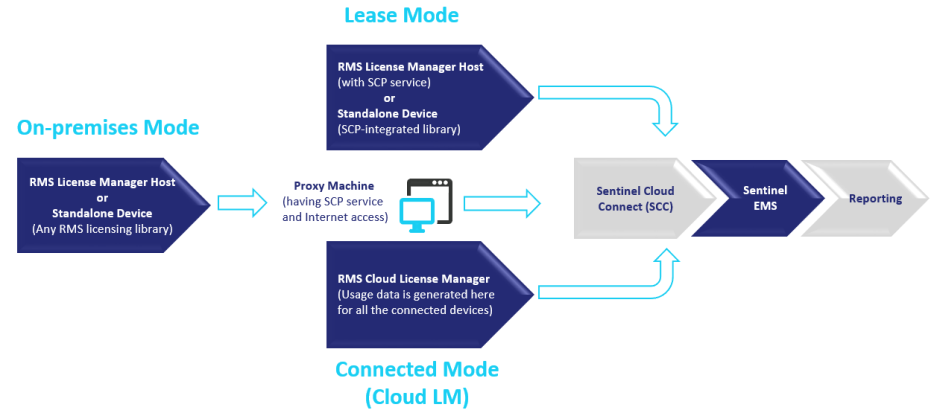Usage Data Generation and Collection
Usage data is generated on the devices that host the RMS License Manager—it can be the same system in the case of standalone licensing, the License Manager in the case of network licensing, or the RMS Cloud License Manager in the case of cloud licensing. Once the usage data is available in the central repository, Sentinel EMS queries the aggregated usage data stored in SCC for the following purposes:
•Generates reports for vendors and customers
•Provides usage analytics for product managers, marketing teams, and business experts
•Exports the partially processed usage data to third-party billing interfaces for customer invoice generation
The following diagram displays how the usage data flows across different components in various deployment modes:

On-premises Mode Workflow
The process of collecting usage data for the On-premises mode includes the following steps:
1.The usage data is collected locally:
•Network On-premises Mode: RMS License Manager maintains usage information from all devices running in a network and keeps them in encrypted form in usage log files.
•Standalone On-premises Mode: The Sentinel RMS licensing libraries maintain usage information and keep them in encrypted form in usage log files.
2.Similar to the Lease mode, usage data is sent from the RMS License Manager or standalone device to SCC with the help of SCP. The difference is that in the Lease mode the procedure is scheduled and automatic whereas in the On-premises mode, the procedure is manual and has to be managed offline by the system administrator on the customer's site. The system administrator needs to perform the following tasks. For details about the offline usage workflow, refer to the Sentinel RMS Developer Guide:
a. Copies the usage data from the source device(can be the RMS License Manager's host and/or standalone device) into a storage device.
b.Copies the usage data from the storage device to a proxy machine that has internet access and SCP installed (in offline mode) for transmitting usage data.
c.On the proxy machine, SCP transmits the usage records to SCC. On completion of usage records transmission, acknowledgment files (having the .ack extension) are created.
d.Copies the usage acknowledgment files from the proxy device to the corresponding source device.
3.SCC processes and aggregates raw usage data according to pre-defined business rules.
4.The aggregated usage data is stored in the SCC database. Sentinel EMS queries the aggregated usage data stored in SCC for various purposes.
Lease Mode Workflow
The process of collecting usage data for the Lease mode includes the following steps:
1.The usage data is collected locally:
•Network Lease Mode: RMS License Manager maintains usage information from all client devices running in a network and keeps them in encrypted form in usage log files.
•Standalone Lease Mode: The SCP-integrated library maintains usage information and keeps them in encrypted form in usage log files.
2.The usage data in the usage log file is sent from RMS License Manager or the standalone client device to SCC. The frequency at which usage data is synchronized with SCC is configured in Sentinel EMS at the time of entitlement creation. If there are multiple entitlements and different usage frequency values are defined, then the smallest value is used for pushing all the usage data.
3.SCC processes and aggregates raw usage data according to pre-defined business rules.
4.The aggregated usage data is stored in the SCC database. Sentinel EMS queries the aggregated usage data stored in SCC for various purposes.
Connected Mode (Cloud LM) Workflow
The usage data is collected and managed on the RMS Cloud LM regardless of API used (Unified API of the SCP-integrated library or the RMS Cloud REST API) for integration.
The process of collecting usage data includes the following steps.
1.Usage is generated where application is running and collected in SCC.
2.SCC processes and aggregates raw usage data according to pre-defined business rules.
3.The aggregated usage data is stored in the SCC database. Sentinel EMS queries the aggregated usage data for various purposes.